I first observed the uncanny paintings of Ambera Wellmann in an intimate solo show at Toronto’s now-defunct Richard Rhodes Dupont Projects. A natural light flooded in and complicated the paintings’ surfaces, which themselves imagined a porcelain glint – a polished skin both lambent and scattering. Amorphous shapes and boneless bodies populated those cryptic canvases, which shimmered with details like delicate Renaissance hands, flashing animal eyes; curious, moving, nighttime forms; translucent, white-blue skin shifting under shadow, or stilled by historicizing light. Wellmann’s first professional outing rippled with its own pleasure while endowing movement and melancholy to the difficulty of mortal objects. They appeared caught in the act of becoming – which felt fitting for a recent graduate’s first work. Wellmann, like her restless nocturnal subjects, seemed to be at once nervous, ambitious, and caught surprised by our look.
Clay Pigeon was exhibited only two months after Wellmann graduated from the University of Guelph, an art school known for its painting program. There was some attention being paid already, with her winning the Joseph Plaskett Prize and taking its European travel component to Berlin, where she remained. But still, Wellmann’s rise has been striking, both for her quick ascendency to international consciousness (she boasts nearly 70,000 Instagram followers), but also for the chances she’s taking during this closely-observed moment.
In a current show at Montreal’s Projet Pangée, (Wo)man and Beast in the Round of Their Need, Wellmann demonstrates a rougher-hewn canvas – and a rougher-hewn subject – in a series of sanded-down and crudely exuberant erotic exchanges. With legs like divining rods to the sky and to the bedposts, these small, frenetic figures go charged by saturated, fresh, almost corny color. Where before there was a mottling of bruised skin, for instance – a poised, taut, and headless torso, breathing shallowly against its inky theater – Wellmann has replaced it with panting bellies, bleeding edges; palimpsestic and “unfinished” painting; her desiring, chafing forms now shouting color; and a more personal evaluation of female pleasure.
It’s a body of work that, a mere two-and-a-half years out of grad school – and following an RBC Canadian Painting Competition prize, in 2017, that cemented the success of her earliest work – heralds an emerging talent’s bravery, vulnerability, and self-challenge. As we sat down for a conversation on my couch in Toronto, on a dark and damp October evening, Wellmann was arriving straight from Art Toronto, and before that, Paris’s FIAC art fair, where she’d been met with a waiting list of more than 100 collectors vying for her work. She found the skirmish “repellent,” she said, and I sense she wished she could stand still and take stock. But in the coming months, she has solo shows at Lulu, in Mexico City (February); Kraupa-Tuskany Zeidler in Berlin (June); and inclusions in group exhibitions at Warsaw’s MoMA and the Australian Centre for Contemporary Art, among others. So, cheered by a glass of white wine, and a shared desire to see the larger picture, we simply dove in.
There is a moment happening in your practice. What do you accredit this past year’s acceleration to? Is this a lasting glow from the RBC prize, or?
The RBC was amazing for Canada, but I was already living in Berlin, so after I went back, nobody knows what it is.
I was thinking about that today, “does the RBC translate?”
Not at all! It’s practically meaningless over there. I’m like, “oh I won this painting competition!” [laughs], which is basically the most humiliating thing to say – because if it’s unfamiliar to people, it sounds like “live art at the easel” or something. But it’s this big prestigious award in Canada, and that was good. But you can’t dwell on that for too long. You just want to get back to work.
And – the image of this one work goes everywhere; you feel some pressure to make that kind of work [again]. But I felt completely anonymous in Berlin, which was good, so I could duck out from under the award and go straight back to the studio.
What precipitated the move to Berlin?
I won the Joseph Plaskett Award, which forces you to go to Europe – horrible! [laughs] – and I’d been researching Meissen porcelain during my MFA. So I received this award to go to Berlin and travel and research through Italy on my way there. When I made it to Berlin, I just stayed.
It suits you.
Yeah, it suited me, and though it’s not a great painting city, it can be a little dry and conceptual, it was just nice to get out of Canada. I felt really stifled in Toronto, to be totally honest. There’s lots of support here and friendships, but it was important for me to go somewhere different. I think it’s healthy to move every couple of years.
Does the stifling come with overfamiliarity?
Yeah, that expression “familiarity breeds contempt” … what can I say, I love a lot of the galleries here, and I have so many artist friends here. I don’t know quite how to describe it. I was creatively exhausted. And the painting that I submitted to the RBC was a conclusive painting. It was the end of a series, it did everything that I wanted to accomplish with that series. And after that I remember going back into the studio and just feeling really tired. Also, so much of what I look at and what feeds my practice is historical art. And we don’t have that here. I just didn’t have physical access to those paintings. I look at Ingres, I look at Courbet, I look at Renaissance art, Hieronymus Bosch, Bruegel … nothing makes me want to paint more than looking at that stuff. Ever. So moving was important for me.
Do you decide a city by its holdings, then?
A little bit. Berlin is great because you have access to Madrid, London, Paris, really quickly and cheaply. And I chose Berlin because it’s central, affordable, and I already knew a few people there. But also, this town that this porcelain is named after, Meissen, is about an hour outside of Berlin.
I don’t know much about Meissen. Can you tell me a bit about its role in your painting?
Well, I never ended up going. [laughs] Don’t tell! [laughs] No, I was working my way out of that series. It’s funny when you realize you’ve gotten it to do everything it can do. And then you have to go through that horrible period, where you’re just in your studio waiting for a discovery. You’ve finished, and then you go through the motions for a little while. I was getting bored. You know that expression, “no surprise for the writer, no surprise for the reader.”
When you were done with that series, then, was it due to the outside reception or something that you’d realized internally, even before that big prize?
I mean, you can feel it. I had a studio visit with someone, and she came to the studio right before I was about to leave Toronto, and it was full of porcelain paintings, and we say “hi!”, and she’s energetic and bouncy, and then she walks inside the studio, and literally her body – she just sulked into a chair, exhausted. I was like, “oh great, this is what my work is doing to a person.” And I felt it too. The studio was … dry. It’s like being in a relationship too long, after the sex goes bad. I had nothing left, no interest in the subject anymore. So it wasn’t even the award – I just felt bored.
What does it feel like to be receiving such a big moment and this repeated citation of a work that you’re feeling so done with? To extend your analogy, is it like being praised for a relationship that you’ve just broken up, having to perform that you’re still together?
[laughs] Yeah! I mean I love that painting, it’s still a complicated painting for me. It doesn’t have any answers. It asks all sorts of things and doesn’t have any answers. There’s this urge sometimes when you’re painting to answer things. I try to avoid that, actually. A painting should end with a question; it helps lead you to the next one.That painting, it’s so interesting, because you have this feminized material of porcelain in this symbol of the masculine form, but it’s been inverted, flipped upside down so that it’s flaccid. And then you have this historical material but this deeply personal autographic painting on top. It was an important painting because it incubated for a while, and then I realized this moment where I was giving myself an opportunity to free-write on top of it, the incorporation of drawing, free-marking … I just didn’t know its value at this time because it was subsumed into this body of work. But later on, I realize there was this really pronounced moment of freedom where I could incorporate this very personal content into this historical way of working. I just didn’t know. You don’t always know at the time, the value of it to your practice.
Following that work, in the last year, your work changed quite a bit.
My work changed like crazy in the past year. And that was extremely liberating. Because I would toil over a painting for three months at a time, at Guelph, and there was no pleasure in that. It killed me. I love those paintings I made during the two years of my degree, but I started to feel like they became tighter and more controlled and suppressed. There’s a sense of repression in the porcelain works specifically. There would be a loose, wild moment at the end; a spontaneous decision that made all the suffering worthwhile. But spending 3-4 months on a painting is hell, it’s hell. I wanted to confront subject matter more directly, and tackle more explicit subject matter, rather than suppressing or containing it. So the work became more explicitly erotic.
Did it get easier?
Yes. I mean it became harder, because I didn’t have the language for it, and I still don’t. I didn’t have a system of measurement to know whether this was a successful painting, or whether it worked. But it didn’t really matter. It’s interesting to make something you don’t have language for. That’s when the boredom sets in, when you go “oh, I know how to explain this.”
It’s too rare that an artist admits to her art historical attachments, and I love that you do. It’s a privilege available to the artist, to not look – to choose not to be saddled, or in competition with their contemporaries or their past. But you do.
Yeah. You can choose to sample freely or to ignore art history, it’s true. But one of the things I’ve loved about [looking] is that sensuality, and physicality, is a point of access to historical work. And that there is always going to be a source of power in it. I’m interested in the way these images have seduced me. So, I’m picking apart those mechanics a little bit. Using them in this way – like in this Ingres painting you have bright, bright flesh that falls into dark, dark shadow. Full disclosure cascading into complete nothingness. And that’s just – that effect is very interesting. Most of the paintings I’m interested in are paintings of women.
Where did that start?
It’s funny, I have no idea where my interest in art history comes from. I grew up in a log cabin in the middle of the woods, without indoor plumbing until I was 8 years old, no culture, no arts program. My mom had a postcard of Saturn Devouring His Son [Goya, c. 1819-23]. Just that one, and next to it was a Picasso mother nursing her child, from the Blue Period. Just those two, side by side, from her trip to Spain in the seventies.
Wow, that’s a hell of a pairing.
I was so fixated on them. Obsessed. And that painting by Goya, especially, I found so scary as a kid. I loved the darkness, and the way that things fall into darkness. There’s this moment where your imagination finishes things. Finishes the edges of things. It was also horrific to see something desperately eating this other thing. And you have this moment where the body has become dead, in the painting. I don’t think there’s a better painting of a body becoming dead. It’s so incredible. I guess part of my interest in women’s bodies is that they’re so close to becoming dead. But I have desire for them too, intense desire for their bodies.
When my work started to change it was so weird because I had a lover, in Berlin, and we had this amazing connection, and great sex, and almost nothing from my life had ever made me want to paint from personal experience, until that point. And I didn’t do anything for a while, because all of my professors had squashed this idea of making work from personal experience, from my undergrad all the way through my master’s. Eventually I realized, let’s make the wrong thing. Let’s make something that’s been done a million times, and done brilliantly, and just make it. I’m here in Berlin, alone, and nobody knows who I am. I’m going to make what I want. Whether or not they’re good drawings, it was the exercise of giving yourself the freedom to make the thing you that you think is probably the wrong thing to make.
How do you reconstitute desire? How do you pictorially structure female desire in a painting? Because all my structures for desire consisted of paintings that weren’t made for me, and never anticipated me as a viewer. Wow, this is such an interesting painting problem. And then I was jazzed, and juiced up.
You took a muse!
I took a muse, alright. [laughs] I think they were great paintings, and they had so much more economy than whatever I was doing with porcelain. How do you streamline eroticism and structure that desire? Those paintings are of me, most of the time. I’m not identifiable but it’s a different thing when that part is inextricable.
Tell me about the feminist aspect of your practice. A lot of the new press around your work is aligning itself to that perspective, or agenda, and it strikes me that that could be uncomfortable for you. How does it sit?
I don’t want the work to be instrumentalized. I’m wary of that. And I think it’s powerful and important, but I also think a good painting has to transcend its own politics. But I also have guilt about saying that, because a lot of my friends are intense, feminist painters who aren’t afraid to instrumentalize their work in service of their politics, and I admire it. But right now, nothing is planned. There’s no predetermined outcome for the work, and that might be the difference. But the painting has to survive and exist, it just has to be a good work.
You have an outsized social media presence. Can we talk about that? How did you build this following?
I know how it started to happen. I used Instagram to relieve stress, during my MFA, because I was feeling like I had to have an answer for everything before it was even made. And I’m not a photographer but I started to take funny pictures of the body, as a way to explore something as an amateur. I wanted to make something funny, entertaining, and still inevitably connected to my interests as a painter – about the body, eroticism. So I was taking photos of my butt in a bra. And switching out things, swapping an avocado pit for an egg yolk, and that would be a picture. Jerry Saltz started following me, I don’t know why or how, he just did. And he started to repost a lot of the pictures I was making at the time.
With credit?
With credit. And every time he did, 500 people would start following me. Then Vice did an article about the work and I got 6,000 followers that day – in a couple of hours. And I was having fun with the photos, but like with anything else, I was like, “okay, now I know how to make this.” So it got boring; I grew out of it. But they were a major fuel – my Instagram followers were there to be entertained. Luckily, even when I stopped posting those things, people were interested in my paintings; I was able to slowly transition, which is actually surprising to think. [But] I stopped posting works in progress. Paintings that were in the studio. Because the ‘likes’ are not a substitute for criticality, and it can quickly influence your decisions. You get attention. One gallery liked this one, and didn’t like this one? You think [scared], “oooo!” You can sweat that stuff.
Do you have to set up some discipline in your life around it?
If I want to be in the studio that day, I have to not post. Because I’ll be glued to the screen for an hour, after I post [rubbing hands], like “what did we get!?” So, I’m cautious of that.
Smart. Well, I was speaking with my grad students about your work, last week – they’re writing reviews of your show at Project Pangée for the class –
Wow, oh my god!! That’s horrifying! [laughs]
[laughs] So we went around the table and talked about first impressions, and the recurring observation was, “it wasn’t what I was expecting.”
Oh interesting.
And I think that’s because their first initiation to your work was on Instagram, or a thumbnail somewhere. So I asked what was the disjuncture for them, between the screen and in person, and it was largely in the color and scale. The physicality of the work surprised them, sometimes even disappointed them. I’m curious if there’s an airgap in that discrepancy, for you, that’s fun to play with, or if the difficulty of accurately representing your work online is a source of frustration?
I feel like there’s pressure for painters, especially, regarding how conducive their work is to photography. Painters’ work has to live in two places at once – in the flesh, and they also have to document well. You’re making a painting and you’re also making an image. I think, as someone who photographs every stage of the painting in the process, too, I am negotiating whether I like this or not. Because in documenting the work something glaring or problematic will reveal itself immediately to you, where it won’t in the studio.
It flattens it out –
It flattens it out and it also streamlines vision. It eliminates your subjectivity, almost. When I’m in the studio with the painting physically in front of me, I go to what I think are the best parts, and I tend to ignore the things that aren’t working. But when I photograph the painting, everything is available to me at once, and I don’t have the privilege of foregrounding the pleasurable part. I have to see the whole thing. It’s so useful. But almost always the painting is going to be more interesting in person. Almost always, with few exceptions.
Right. I’d like to finish by talking about the gaze within the work, then – the way you depict eyes, typically eliding the distinct features of a face but with pronounced eyes that suggest an interchangeability between the human and the animal visage in your work.
Yes, I humanize animals a lot and I animalize humans. I find animals are so interesting in paintings because they don’t occupy time in the same way that people do. People wear time specifically. Everything, from their fashion to certain faces, fashion, posture, hairstyles. They really occupy time specifically in painting. Which is so interesting, because animals evade that. A dog is always a dog, a horse is always a horse. I had a studio visit with a friend, and there was a little pony painting, and she said, “this looks like it has always existed.” And I thought, “what a wonderful quality for a painting to have.” Where it’s atemporal, or temporally homeless, it gives it a special kind of power. Like how do you make an eye that represents eye?
This lends itself to the amorphous, and the ambiguities in corporeal form, in your paintings. Can you speak to the intersection of absurdity, grotesquerie, and abjection in your work? Are these terms that resonate?
They’re such close cousins. But I’ve always loved the grotesque. I learned recently that “esque” refers to a spiritual essence. I think that’s one of the things that differentiates the grotesque from the abject; the abject is guttural, it’s bodily; the grotesque points to these things, too, but it also points upwards. A quality I look for in painting – to point to something beyond itself.
What they share in common is the corpus being unknowable and strange. And that the grotesque is the word-child of the grotto, to extend yourself vulnerably into a space that you cannot map.
That’s nicely said. Better than my blood and guts … [laughs]
But abjection shares something in common with that, especially as exercised in contemporary art. That quality of estrangement, of “I don’t know that to be my own but it is my own.” Rejection and recognition in the same stroke.
Absolutely. It’s a useful place to move forward from. And then the absurd. That’s almost like a sub-category of these things we’re talking about. I want it to be absurd. Not shocking. But absurd.
























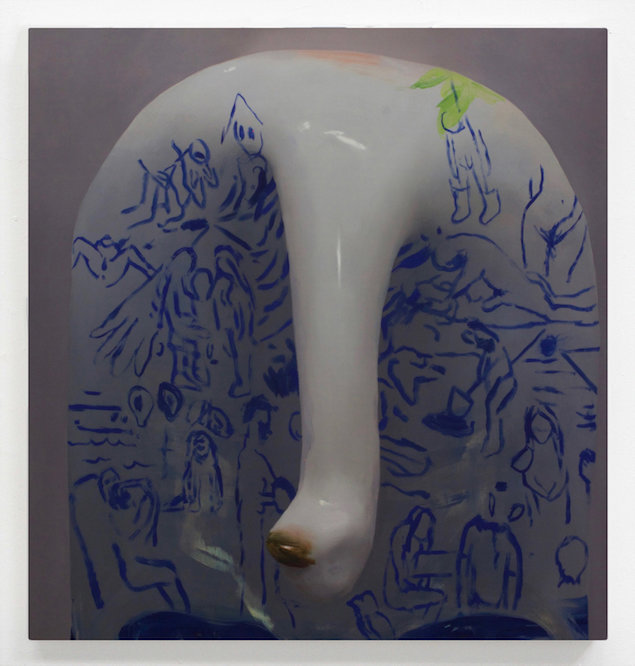
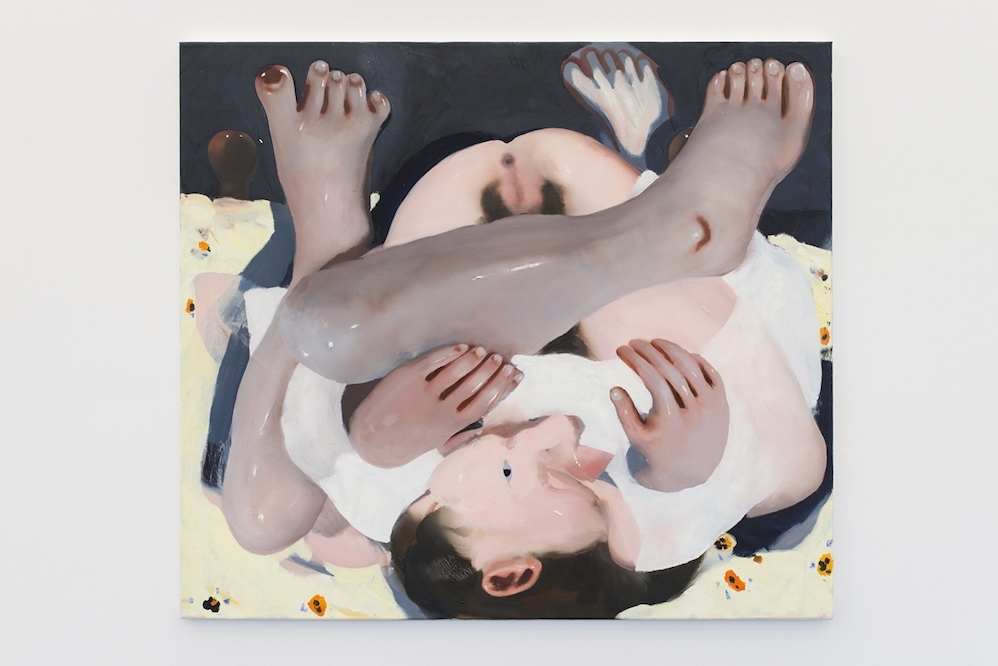
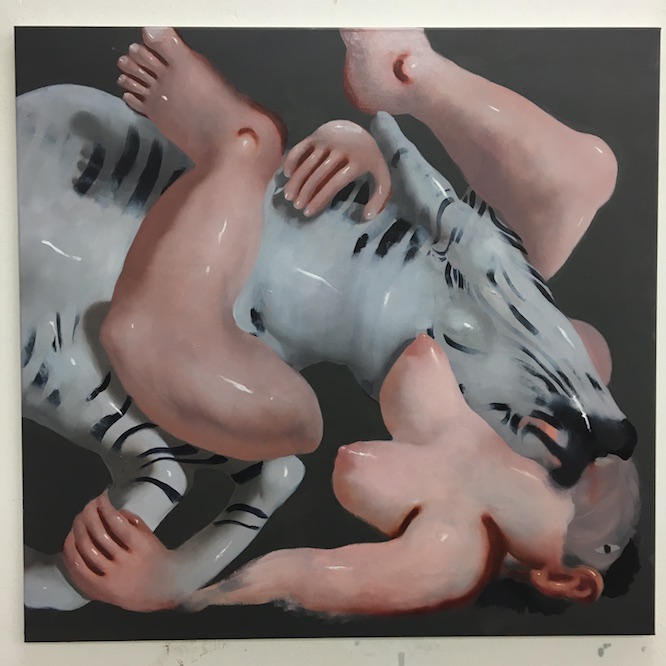

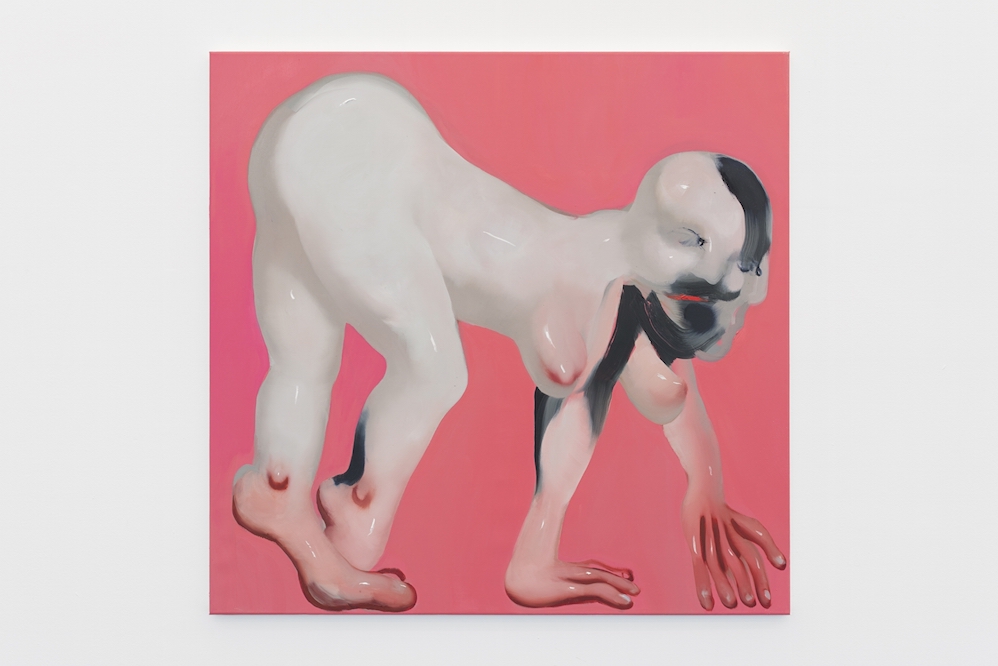
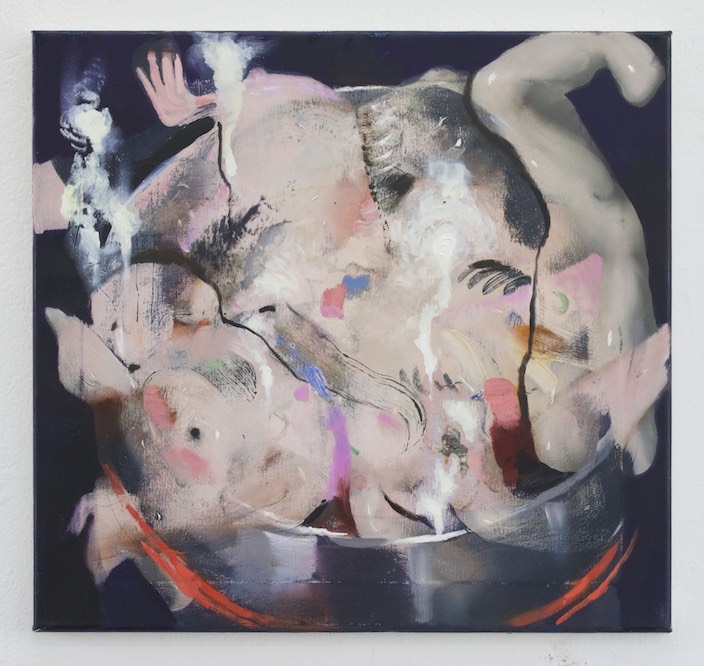



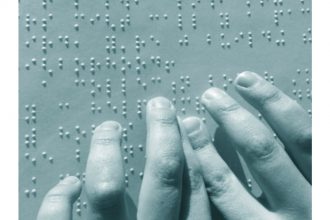
Ambera Wellmann is such a talented artist. I am glad she is getting the recognition she deserves. One of my personal favs!
We should really consider all that she is saying seriously. We need to respect all her experience by making sure that her needs at this time re respected and taken care of.